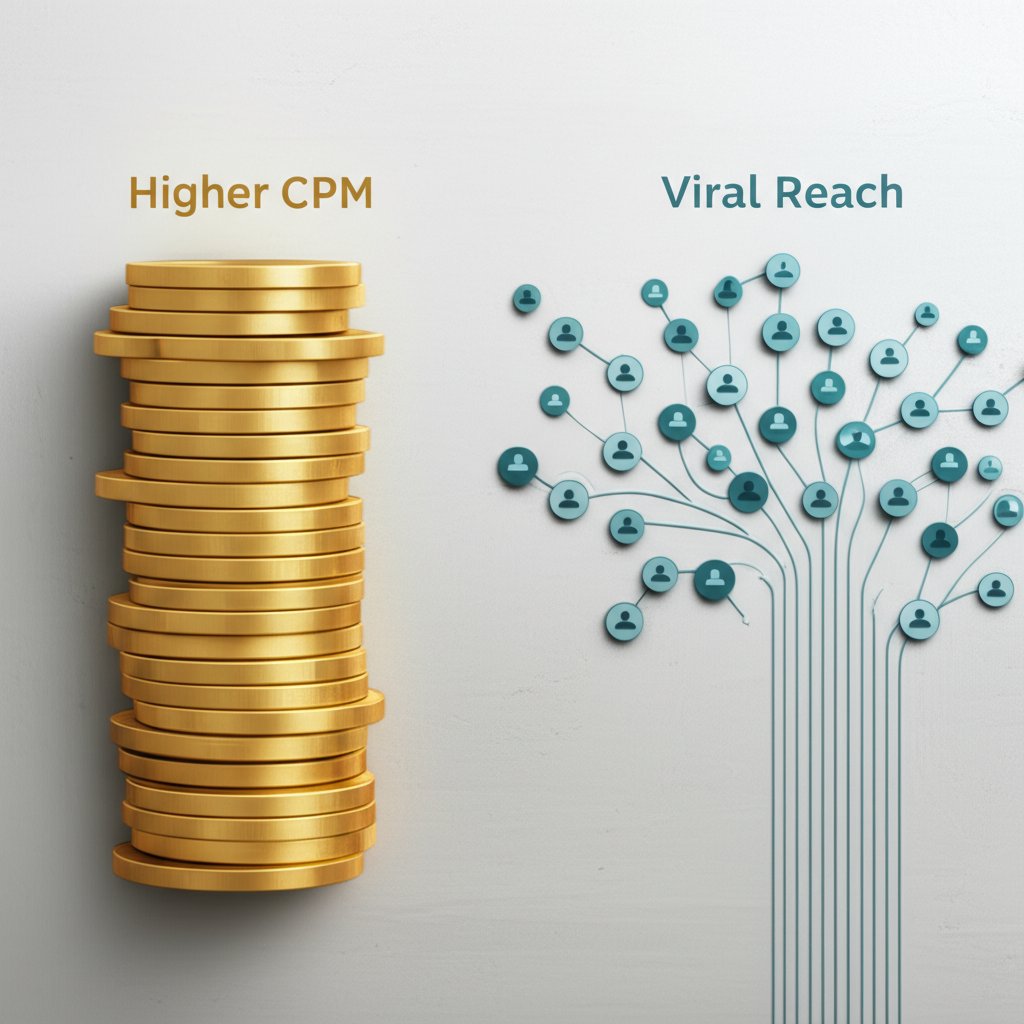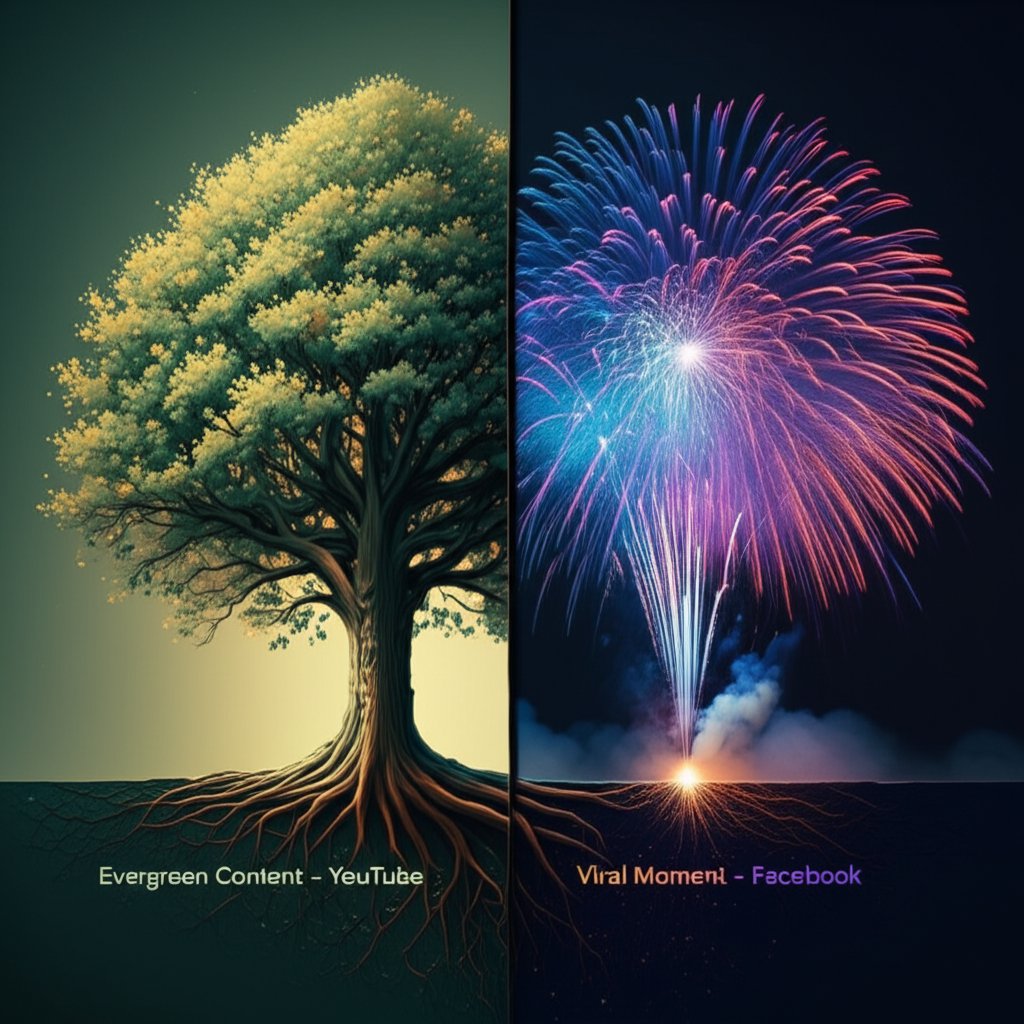TL;DR
When choosing between YouTube vs Facebook, the right platform depends entirely on your goals as a content creator. YouTube excels at long-term, search-based discovery and offers more robust and predictable monetization options, making it ideal for building a sustainable content library. In contrast, Facebook thrives on viral, short-term reach and immediate community engagement, proving more effective for sparking conversations and targeting older demographics like Millennials and Gen X.
Monetization and Earning Potential: A Head-to-Head Comparison
For most creators, the central question in the YouTube vs Facebook debate is simple: which platform pays more? While both giants offer pathways to revenue, their models, requirements, and overall earning potential differ significantly. Understanding these distinctions is crucial for developing a sound financial strategy for your content.
YouTube's monetization is primarily driven by the YouTube Partner Program (YPP), which allows creators to earn a share of revenue from ads shown on their videos. The eligibility criteria are well-established: 1,000 subscribers and 4,000 hours of watch time in the past year (or 10 million Shorts views in 90 days). Once accepted, creators typically receive a generous 55% of the ad revenue. This model is built for sustainable, long-term income, as popular videos can continue to generate revenue for years through search and recommendations.
Facebook's primary monetization tool is In-Stream Ads. The eligibility requirements are steeper in some respects, demanding 5,000 followers and 60,000 total minutes viewed on videos in the last 60 days. While Facebook also offers revenue sharing, its Cost Per Mille (CPM), or the amount earned per 1,000 views, is generally reported to be lower than YouTube's. This means that even with a high view count, the direct ad earnings on Facebook may not match those from a comparable YouTube video.
Beyond ads, both platforms have developed additional income streams. YouTube offers a more mature ecosystem with features like Super Chat and Super Stickers (viewer donations during live streams), channel memberships (paid subscriptions for exclusive content), and a larger market for merchandise and sponsorships. Facebook is building out similar features like Stars (a tipping system) and fan subscriptions, but they are less established. Ultimately, for creators aiming to build a professional career with predictable income, YouTube's platform is designed to be a more reliable and lucrative long-term option.
Monetization Requirements at a Glance
| Metric | YouTube (Partner Program) | Facebook (In-Stream Ads) |
|---|---|---|
| Subscribers/Followers | 1,000 subscribers | 5,000 followers |
| Watch Time/Views | 4,000 watch hours in the last 12 months OR 10 million Shorts views in the last 90 days | 60,000 minutes viewed in the last 60 days |
| Revenue Split | ~55% to creator from AdSense | Similar split, but generally lower CPM |
| Primary Strength | Higher long-term earning potential, more diverse monetization tools | Can monetize viral, short-term content |
Audience & Content Discovery: Search vs. Social
The most fundamental difference between YouTube and Facebook lies in how audiences discover content. This distinction directly impacts content strategy, video longevity, and audience growth. YouTube operates as the world's second-largest search engine, while Facebook is a social discovery platform driven by shares and network effects. This core difference determines whether your content has a fleeting viral moment or a long, evergreen lifespan.
On YouTube, content discovery is primarily search-driven. Users visit the platform with intent, looking for answers, tutorials, reviews, or entertainment on specific topics. As a result, a well-optimized video can be discovered for months or even years after it's published, creating a long-term asset that continuously attracts views and generates revenue. According to some analyses, a YouTube video's effective lifespan can be over 20 days, and much longer for evergreen topics. This makes it the ideal platform for building a searchable library of valuable content.
In contrast, Facebook is built for social discovery and virality. A video's success is heavily dependent on initial engagement—likes, comments, and especially shares—within the first few hours of posting. Content spreads through a user's network of friends, creating the potential for explosive, short-term reach. However, this also means the content has a very short shelf life, often disappearing from news feeds within a day. As noted by Dacast, Facebook videos are less discoverable on search engines, limiting their long-term visibility.
The audience demographics also play a key role. While both platforms boast billions of users (YouTube over 2.5 billion and Facebook over 2.9 billion), Facebook's user base trends slightly older. AIR Media-Tech points out that this makes Facebook a prime platform for targeting Millennials and Gen X. Creators must consider whether their target audience is more likely to actively search for their content (favoring YouTube) or discover it through social sharing (favoring Facebook).

Content Strategy and Engagement Models
The differing discovery models of YouTube and Facebook demand distinct content strategies. Simply re-uploading the same video to both platforms is rarely effective. To maximize performance, creators must tailor their content to fit the viewing habits and engagement patterns unique to each environment. This involves adapting video length, format, and the call-to-action to align with how users consume video on a search engine versus a social feed.
YouTube is a destination for intentional, long-form viewing. Users are often willing to invest more time in high-quality, in-depth content. This makes the platform ideal for tutorials, detailed product reviews, educational series, and documentaries. Production value is often higher, and viewers expect well-researched, structured content. Engagement on YouTube is typically creator-to-audience, centered around the comment section, Super Chats during live streams, and channel memberships that build a loyal following.
Facebook, on the other hand, is designed for interruptive, passive viewing. Videos autoplay in a user's feed as they scroll, meaning content must be immediately engaging to capture attention. Shorter, punchier videos with captions (as many users watch without sound) tend to perform best. Content that sparks conversation, elicits emotional reactions, and encourages shares—such as viral clips, live streams, and community updates—thrives in this environment. As one analysis notes, engagement on Facebook is more of a network effect, where a view can lead to a new connection, making it powerful for community building. For creators looking to scale their output, tools like BlogSpark can help generate SEO-optimized article ideas and drafts, freeing up time to focus on video production and community management.
Here’s a breakdown of how engagement features compare:
- YouTube Engagement: Primarily focused on building a loyal subscriber base. Key tools include detailed comments, likes/dislikes, channel memberships for exclusive content, and Super Chats for direct financial support during live streams.
- Facebook Engagement: Built around social interaction and shareability. Key tools include reactions (Like, Love, Haha), comments that tag friends, and powerful sharing functions. Facebook Groups also offer a potent way to build and engage a dedicated community around your content.
A smart strategy often involves using the platforms in tandem. A creator might post a full-length, detailed tutorial on YouTube and then create a shorter, attention-grabbing teaser or a behind-the-scenes clip for Facebook to drive awareness and conversation, linking back to the main YouTube video.
The Verdict: Which Platform Should You Prioritize?
Ultimately, the choice between YouTube and Facebook is not about which platform is definitively "better," but which one aligns best with your specific goals, content style, and target audience. Instead of viewing it as an either/or decision, a strategic approach involves prioritizing one platform as your primary hub while using the other to complement your efforts. By understanding their core strengths, you can make an informed decision that maximizes your return on investment.
Choose YouTube if...
Your primary goal is long-term revenue and building a sustainable career as a creator. You produce evergreen content like tutorials, reviews, or educational series that people will search for over time. You want to become a recognized authority in a specific niche and build a searchable library of high-quality videos. Your strategy relies on SEO and discoverability through search engines like Google.
Choose Facebook if...
Your main objective is rapid brand awareness and achieving viral reach in a short period. Your content is timely, conversation-starting, and designed to be shared within social circles. You are focused on engaging an existing community or targeting a slightly older demographic (Millennials and Gen X). You heavily utilize live streaming for real-time interaction and community events.
The most powerful strategy often involves using both platforms synergistically. Use YouTube as the home for your core, monetizable, long-form content. Then, leverage Facebook to distribute shorter clips, behind-the-scenes content, and community updates that drive traffic and awareness back to your YouTube channel. This allows you to capitalize on Facebook's viral potential while building a lasting, revenue-generating asset on YouTube.
To make your final decision, ask yourself these key questions:
- What is my primary goal: sustainable revenue or immediate reach?
- Is my content something people actively search for (e.g., "how to fix a leaky faucet") or something they would share with friends (e.g., a funny clip)?
- Who is my target audience, and where do they spend most of their time online?
- What is the expected lifespan of my content: will it be relevant for years or just a few days?

Frequently Asked Questions
1. Which is better, YouTube or Facebook?
Neither platform is universally better; the best choice depends on your objectives. YouTube is superior for creators seeking long-term monetization and building a searchable, evergreen content library, as its videos have a much longer shelf life and benefit from search engine discovery. Facebook is better for achieving short-term viral reach, fostering immediate community engagement through shares and comments, and targeting a slightly older demographic.
2. Is YouTube better than social media?
YouTube functions differently from traditional social media platforms like Facebook. While it has social elements, its core strength is as a video search engine. This gives it a key advantage in terms of content longevity and reach. Unlike a Facebook post that is visible primarily to your network and has a lifespan of a few hours, a YouTube video can be discovered by anyone in the world through search for months or even years. This makes it a more powerful tool for building a lasting brand and a consistent source of traffic.




